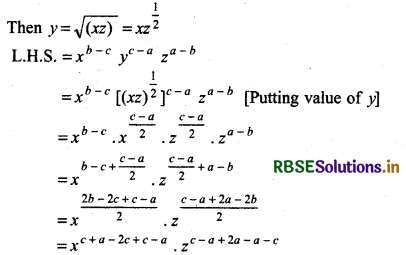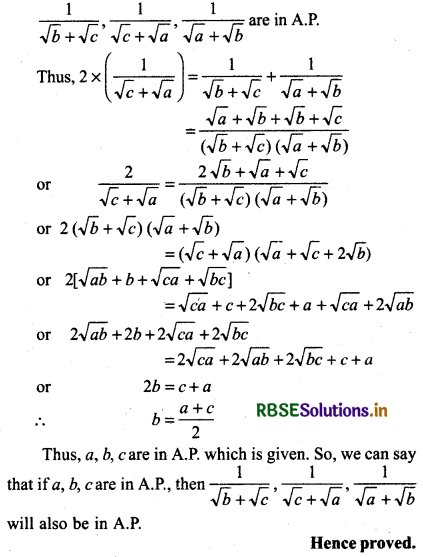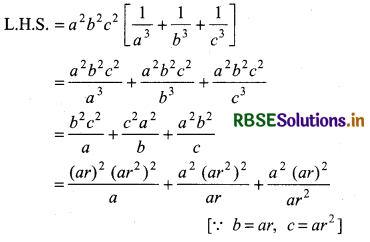RBSE Class 11 Maths Important Questions Chapter 9 Sequences and Series
Rajasthan Board RBSE Class 11 Maths Important Questions Chapter 9 Sequences and Series Questions and Answers.
Rajasthan Board RBSE Solutions for Class 11 Maths in Hindi Medium & English Medium are part of RBSE Solutions for Class 11. Students can also read RBSE Class 11 Maths Important Questions for exam preparation. Students can also go through RBSE Class 11 Maths Notes to understand and remember the concepts easily.
RBSE Class 11 Maths Chapter 9 Important Questions Sequences and Series
Question 1.
If a, b, c are in Arithmetic Progression and x, y, z are in geometric progression, then prove that
(i) xb - c. yc - a . za - b = 1
(ii) xb yc za = xc ya zb
Answer:
(i) We have, a, b, care in AP.
Then 2b = a + c .................... (1)
and x, y, z are in G.P.

[Putting 2b = c + a from equation (1)]
= x0 × z0
= 1 × 1
= 1
= R.H.S.
Hence Proved.
(ii) ∵ xb - c yc - a za - b = 1 [From part(i)]
⇒ xb . x-c . yc . y-a za . z-b = 1
⇒ \(\frac{x^b}{x^c} \cdot \frac{y^c}{y^a} \cdot \frac{z^a}{z^b}\) = 1
∴ xb yc za = xc ya zb

Question 2.
If a, b, c are in G.P., then prove that log an, log bn, log cn will be in A.P. .
Answer:
Let log an, log bn, log cn are in A.P.
[∵ If x, y, z are in A.P. then 2y = x + z]
Then 2 × log bn = log an + log cn
= n log a + n log c [∵ log am = m log a]
= n[log a + log c]
= n log (ac) [∵ log m + log n = log m × n]
or log (bn)2 = log (ac)n
Comparing on both sides
(bn)2 = (ac)n
⇒ (b2)n = (ac)n
⇒ b2 = ac
Thus, a, b, care in GP. which is given.
Hence proved.
Question 3.
If a, b, c, d are in GP. then prove that (a + b) (b + c) (c + d) will be in GP.
Answer:
We have a, b, c, d are in GP.
Then common ratio = \(\frac{b}{a}\) = \(\frac{c}{b}\) = \(\frac{d}{c}\) = r (say)
Thus \(\frac{b+c}{a+b}\) = \(\frac{c+d}{b+c}\) (By proportionality law)
or (b + c)2 = (a + b) (c + d)
Thus (a + b), (b + c), (c + d) are in GP.
Hence proved.
Alternative Method
Given a, b, c, d are in GP.
Thus, common ratio = \(\frac{b}{a}=\frac{c}{b}=\frac{d}{c}\) = r (say)
⇒ b = ar,
c = br = ar. r = ar2,
d = cr = ar2 . r = ar3
∴ a + b = a + ar = a (1 + r)
b + c = ar + ar2 = ar(1 + r)
and c + d = ar2 + ar3 = ar2(1 + r)
Thus \(\frac{b+c}{a+b}=\frac{a r(1+r)}{a(1+r)}\) = r
and \(\frac{c+d}{b+c}=\frac{a r^2(1+r)}{a r(1+r)}\) = r
Since, there common ratio is same therefore, (a + b, (b + c), (c + d)are in GP.
Hence proved.

Question 4.
If a, b, c are in A.P. (where a, b, c are positive numbers), then prove that
\(\frac{1}{\sqrt{b}+\sqrt{c}}, \frac{1}{\sqrt{c}+\sqrt{a}}, \frac{1}{\sqrt{a}+\sqrt{b}}\)
will also in A.P.
Answer:

Question 5.
If between two numbers a and b, we placed a G.M. G and two A.M. p and q then prove that
G2 = (2p - q) (2q - p)
Answer:
We have,
G is GM. of a and b
then G2 = ab ......................... (1)
Again, p and q are two arithmetic mean between a and b, then a, p, q, b will be in A.P.
Their common difference ⇒ p - a = q - p = b - q
Now, taking p - a = q - p
2p - q = a .................... (2)
Again, taking q - b = p - q
q + q = b + p
or 2q - p = b ..................... (3)
Multiplying equations (2) and (3)
(2p - q) (2q - p) = ab = G2 [From equation (1)]
⇒ G2 = (2p - q) (2q - p)
Hence proved.

Question 6.
If a, b, c are in G.P., then prove that
a2 b2 c2 \(\left(\frac{1}{a^3}+\frac{1}{b^3}+\frac{1}{c^3}\right)\) = a3 + b3 + c3
Answer:
We have a, b, care in G.P.
then b2 = ac
And common ratio r = \(\frac{b}{a}=\frac{c}{b}\)
then b = ar, c = br = ar. r = ar2

= a3r6 + a3r3 + a3
= a3 + a3r3 + a3r6
= a3 + (ar)3 + (ar2)3
= a3 + b3 + c3 (∵ b = ar, c = ar2)
= R.H.S.
Multiple Choice Type Questions
Question 1.
If (a - b)2, (b - c)2, (c - a)2 are in A.P then \(\frac{1}{a-b}, \frac{1}{b-c}, \frac{1}{c-a}\) will be in:
(a) A.P.
(b) G.P.
(c) H.P.
(d) None of these
Answer:
(a) A.P.
Question 2.
If (m + n)th term and (m - n)th term of any G.P. are 9 and 4 respectively, then mth term will be:
(a) 6
(b) \(\frac{1}{6}\)
(c) - 6
(d) None of these
Answer:
(d) None of these
Question 3.
Sum of numbers divisible by 7 from 100 to 300 will be
(a) 5586
(5) 5086
(c) 8588
(d) 5486
Answer:
(a) 5586

Question 4.
The sum of n terms of \(\frac{1}{2}+\frac{3}{4}+\frac{7}{8}+\frac{15}{16}+\ldots\) is:
(a) n - 1 + 2-n
(b) n2-n
(c) 1 - n + 2-n
(d) 2n - 2 + 2-n
Answer:
(a) n - 1 + 2-n
Question 5.
The sum of an infinite G.P. is 23 and sum of square of infinite terms is 69. Then its first term will be:
(a) \(\frac{69}{13}\)
(b) \(\frac{10}{3}\)
(c) \(\frac{9}{10}\)
(d) \(\frac{13}{69}\)
Answer:
(a) \(\frac{69}{13}\)
Question 6.
The sum of 1.2.3 + 2.3.4 + ......... n terms will be:
(a) \(\frac{(n+1)(n+2)(n+3)}{4}\)
(b) \(\frac{2 n(n+1)(n+2)(n+3)}{3}\)
(c) \(\frac{n(n-1)(n-2)(n-3)}{4}\)
(d) \(\frac{n(n+1)(n+2)(n+3)}{4}\)
Answer:
(d) \(\frac{n(n+1)(n+2)(n+3)}{4}\)
Question 7.
The sum of terms of an infinite GP. is 3 and sum of squares of its terms is also 3 then first term and common ratio of series are:
(a) \(\frac{3}{2}\), 2
(b) 1, \(\frac{1}{2}\)
(c) \(\frac{3}{2}\), \(\frac{1}{2}\)
(d) None of these
Answer:
(c) \(\frac{3}{2}\), \(\frac{1}{2}\)
Question 8.
mth term of A.P. be n and nth term of AP. be m
then pth term will be:
(a) m + n
(b) m + n - p
(c) m2 + n2 - p
(d) m - n + p
Answer:
(b) m + n - p

Question 9.
In a G.P., the 3rd term is 24 and the 6th term is 192.
Its 10th term will be:
(a) 7132
(b) 2371
(c) 3072
(d) 1732
Answer:
(c) 3072
Question 10.
If there are five G.M. between 486 and \(\frac{2}{3}\), then fourth GM will be:
(a) - 6
(b) 6
(c) - 12
(d) 12
Answer:
(b) 6
Question 11.
Sum of terms of sequence:
1 + (1 + 3) + (1 + 3 + 5) + ....... + (n - 1)
(a) \(\frac{n^2(n+1)^2}{4}\)
(b) n2
(c) \(\frac{n(n-1)(2 n-1)}{6}\)
(d) None of these
Answer:
(c) \(\frac{n(n-1)(2 n-1)}{6}\)
Question 12.
Sum of \(\frac{1}{1}+\frac{1}{1+2}+\frac{1}{1+2+3}\)+ ........ (n + 1)tennis:
(a) \(\frac{2 n}{n+1}\)
(b) \(\frac{n}{n+1}\)
(c) \(\frac{2(n+1)}{n+2}\)
(d) \(\frac{2}{n(n+1)}\)
Answer:
(c) \(\frac{2(n+1)}{n+2}\)
Question 13.
For all positive integers for n
3.1.2 + 3.2.3 + 3.3.4 + ....... 3[n(n + 1)] equals:
(a) n(n + 1) (2n + 1)
(b) n(n + 1) (n + 2)
(c) \(\frac{(n-1) n(n+1)}{2}\)
(d) n(n - 1) (n + 1)
Answer:
(b) n(n + 1) (n + 2)
Question 14.
The 20th term of the sequence defined by
an = (n - 1) (2 - n) (3 + n) is:
(a) - 7866
(b) - 6786
(c) 6678
(d) 8766
Answer:
(a) - 7866

Question 15.
The 10th common term between the series 3 + 7 + 11 + ......... and 1 + 6 + 11 + ......... is:
(a) 193
(b) 211
(c) 191
(d) 190
Answer:
(c) 191
Fill in the Blanks
Question 1.
The 10th term of the series - 4 - 1 + 2 + 5 + is ........................ .
Answer:
23
Question 2.
If a, b, c are in GP., then the value of \(\frac{a-b}{b-c}\) is ................................. .
Answer:
\(\frac{1}{r}\)
Question 3.
If the third term of a G.P. is 4, then the product of first five term is .............................
Answer:
45
Question 4.
The value of \(4^{\frac{1}{3}} \cdot 4^{\frac{1}{9}} \cdot 4^{\frac{1}{27}}\) is ............................... ∞
Answer:
2
Question 5.
If the sum of an A.P. is n2 + n, then its nth term is ..............................
Answer:
2n
Question 6.
The value of 12 + 22 + 32 + 42 + ......... + n2 is ..........................
Answer:
\(\frac{n(n+1)(2 n+1)}{6}\)
Question 7.
The geometric mean of numbers 6 and 24 is ..........................................
Answer:
12
Question 8.
The value of 13 + 22 + 33 + ....................... + n3 is .......................................
Answer:
\(\left(\frac{n(n+1)}{2}\right)^2\)

Question 9.
The sum of the series
52 + 62 + 72 + 82 + 92 + .................... + 152 is ....................................
Answer:
1310
Question 10.
The arithmetic mean of two numbers x2 and y2 is ...............................
Answer:
\(\left(\frac{n(n+1)}{2}\right)^2\)
True/False
Write (True) for correct statement and (False) for incorrect statement.
Question 1.
If the sum of n term of a sequence is a quadratic expression, then it is always an A.P.
Answer:
True
Question 2.
The sum of the series 1 + 2 + 3 + 4 + ......... + upto (n - 1) terms is \(\frac{n(n+1)}{2}\).
Answer:
False
Question 3.
The sum of the series 1 + 2 + 22 + 23 + 24 + .......................... ∞ is \(\frac{1}{2}\).
Answer:
False
Question 4.
The sum or difference of two G.P. ¡s again G.P.
Answer:
True
Question 5.
If a,b, care in A.P. then
\(\frac{1}{\sqrt{b}+\sqrt{c}}, \frac{1}{\sqrt{c}+\sqrt{a}}, \frac{1}{\sqrt{a}+\sqrt{b}}\) are also in AP.
Answer:
True

Question 6.
The value of the sum of the series 2 + 4 + 8 + ...................... upto 10 terms is 2044.
Answer:
False
Question 7.
The common ratio of a, G.P. 2 + 0.2 + 0.02 + .................................... is 10.
Answer:
False
Question 8.
The geometric mean of the numbers (x - y)2 and (x + y)2 is (x2 - y2).
Answer:
True
Question 9.
The th term of the series 12 + (12 + 22) + (12 + 22 + 32) + ................... is \(\frac{1}{6}\)(2n3 + 3n2 + n).
Answer:
True
Question 10.
There are 20 terms in the series 3, 5, 9, ............................. 51.
Answer:
False

- RBSE Solutions for Class 11 Maths Chapter 3 त्रिकोणमितीय फलन Ex 3.1
- RBSE Solutions for Class 11 Maths Chapter 2 संबंध एवं फलन विविध प्रश्नावली
- RBSE Solutions for Class 11 Maths Chapter 2 संबंध एवं फलन Ex 2.3
- RBSE Solutions for Class 11 Maths Chapter 2 संबंध एवं फलन Ex 2.2
- RBSE Solutions for Class 11 Maths Chapter 2 संबंध एवं फलन Ex 2.1
- RBSE Solutions for Class 11 Maths Chapter 1 समुच्चय विविध प्रश्नावली
- RBSE Solutions for Class 11 Maths Chapter 1 समुच्चय Ex 1.6
- RBSE Solutions for Class 11 Maths Chapter 1 समुच्चय Ex 1.5
- RBSE Solutions for Class 11 Maths Chapter 1 समुच्चय Ex 1.4
- RBSE Solutions for Class 11 Maths Chapter 1 समुच्चय Ex 1.3
- RBSE Solutions for Class 11 Maths Chapter 1 समुच्चय Ex 1.2